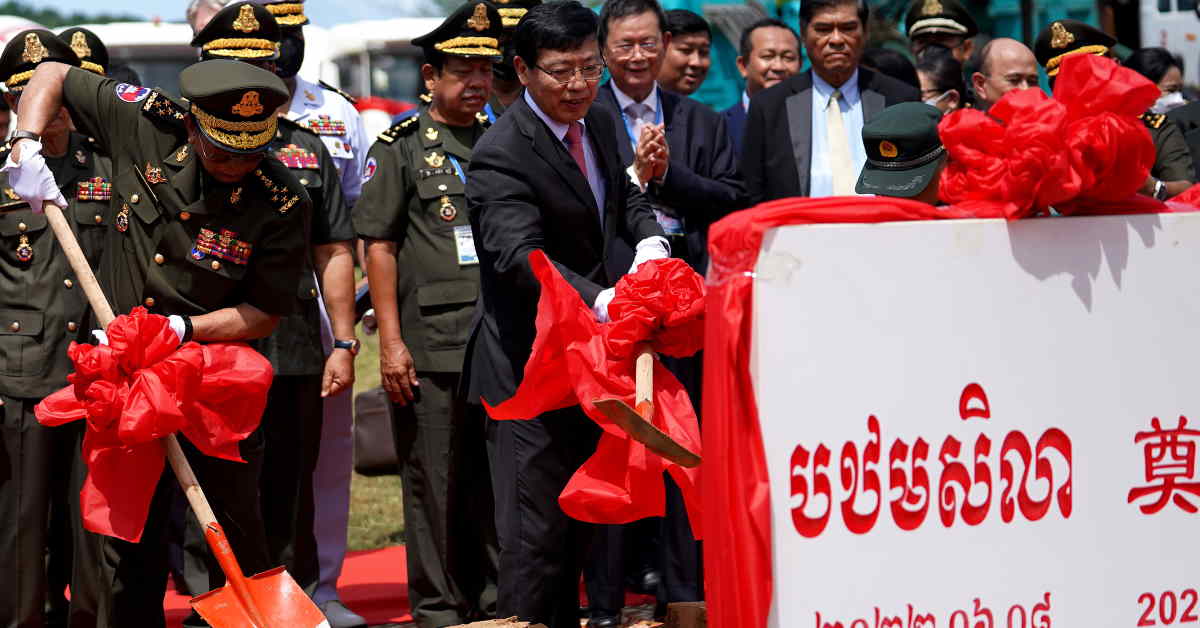At a ceremony this week, Cambodian and Chinese officials proclaimed their friendship as they announced a new construction project. Holding spades decorated with red bows, they turned over soil to signal the start of building work at Cambodia’s biggest naval base, Ream. It will be expanded and renovated, thanks to a Chinese grant of an undisclosed sum – a development that has alarmed the United States (US).
“China and Cambodia have become ironclad brothers,” said China’s ambassador to Cambodia, Wang Wentian, at the ceremony.
For years, reports have circulated about the base, suggesting that Cambodia planned to grant exclusive use to China’s military. Such an arrangement would give Beijing enhanced access to the contested South China Sea (SCS), and mark a major expansion of its military and economic clout in the Indo-Pacific.
The US has repeatedly expressed concern, and accused Cambodia of lacking transparency over the arrangement. This week, Cambodia reiterated denials, saying China would not have exclusive access. “It can’t be a port that would threaten any countries,” said defence minister Tea Banh.
Analysts say it is too soon to fully understand the nature of the arrangement. “We do know that China wants to project power further away from the Chinese mainland, and to do that it needs to establish a logistics network to service its naval vessels,” said Dr Matthew P Funaiole at the Centre for Strategic and International Studies (CSIS) which has been monitoring the construction.
Beijing will probably be cautious about how any development is presented, however. “They know the word ‘base’ is likely to raise red flags, so try to sidestep that kind of phrasing,” added Funaiole.
Cambodia, China’s closest ally in Southeast Asia, is an unsurprising partner for the development. China has pumped billions of dollars into Cambodia through development assistance, loans and other business deals.
“This is an alliance of similarly minded autocratic countries, of single-party rule countries that see eye-to-eye in the way in which they operate,” said Sophal Ear, associate professor at the Thunderbird School of Global Management, Arizona State University.
Hun Sen, who has ruled Cambodia for more than 37 years, has in turn backed China’s interests at regional meetings of the Association of Southeast Asian Nations (ASEAN), including in the disputed SCS, where China and multiple ASEAN members have competing territorial claims.
Reports of China’s possible military presence in Cambodia will be closely watched by Vietnam, which has faced increased assertiveness from China, in the disputed SCS. Others in the region are likely to feel uneasy over the possibility of an escalation in tensions.
Were China to have a presence at Ream, it would be the country’s second foreign naval base, alongside a facility in the east African country of Djibouti.
The construction itself is being carried out by the wholly state-owned China Metallurgical Group Corporation (MCC), which signed a cooperation agreement with Cambodia in 2016. Chinese company records describe it as the “main force in China’s infrastructure construction”.
Ci Le Yi, a Taiwan-based military expert, said Beijing had spent years building its military might abroad. Its ambition is to establish a “string of pearls” in military ports that would allow the People’s Liberation Army (PLA) to park aircraft carriers and submarines, neither of which are nuclear powered, for resupply.
“Cambodia can be their first stop after exiting the South China Sea, and then it’s Bangladesh, then Sri Lanka,” said Ci. “They then arrive at the Persian Gulf and north Africa, and link to Djibouti.”
A Symptom Of US Neglect?
In 2021, a US government report on military developments related to China commented that Beijing was “pursuing additional military facilities to support naval, air, ground, cyber, and space power projection”, and that it had likely considered a number of countries including not only Cambodia but also neighbouring Myanmar, Thailand, Singapore, Indonesia, and others as locations for PLA facilities.
Analysts say there is little chance such Southeast Asian countries would express willingness in doing so, but add that the US has neglected the region.
Frequent public protests from the US over Ream indicate a “lack of leverage and relationship”, said Evan Laksmana, a senior research fellow with the Centre on Asia and Globalisation at the National University of Singapore. They are also unlikely to yield results, he added. “Once it’s out in the public, then the domestic political stakes for Cambodia to not back down will increase.”
A common complaint across Southeast Asia is that “the US only engages us because of China. But if there’s no China, then very likely, we’re just an afterthought,” said Collin Koh, a research fellow at the S Rajaratnam School of International Studies. If the US wants to build trust it should be more consistent, and offer something other than a focus on security, he added.
Seeking to present itself as a champion of human rights is also unlikely to win over Southeast Asian leaders, added Laksmana. “The US does not have as strong a moral high ground as it likes to think it has in Southeast Asia. So, a values-first approach doesn’t really resonate.”
Zhao Tong, a senior associate at the Beijing-based Carnegie Endowment for International Peace, said China saw itself as a future international leader, whose global influence would eventually catch up to and maybe exceed the US.
But he said the process of establishing an overseas military presence would be incremental, with Beijing preferring to keep a low profile and avoid “international suspicion”.
“Chinese experts seem to believe that as China gradually expands its military influence, from its own neighbourhood to regions further away from its shores, the international community would become used to the presence of greater Chinese power and over time might develop an increasingly favourable view towards it,” he said.
“For many Chinese experts, this is how new changes in the international balance of power take place and get normalised.”
